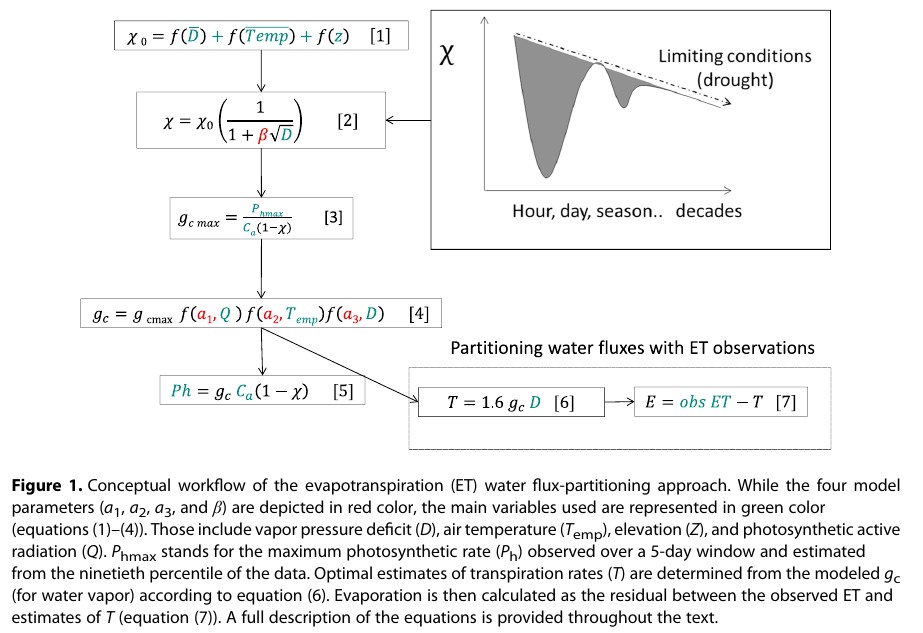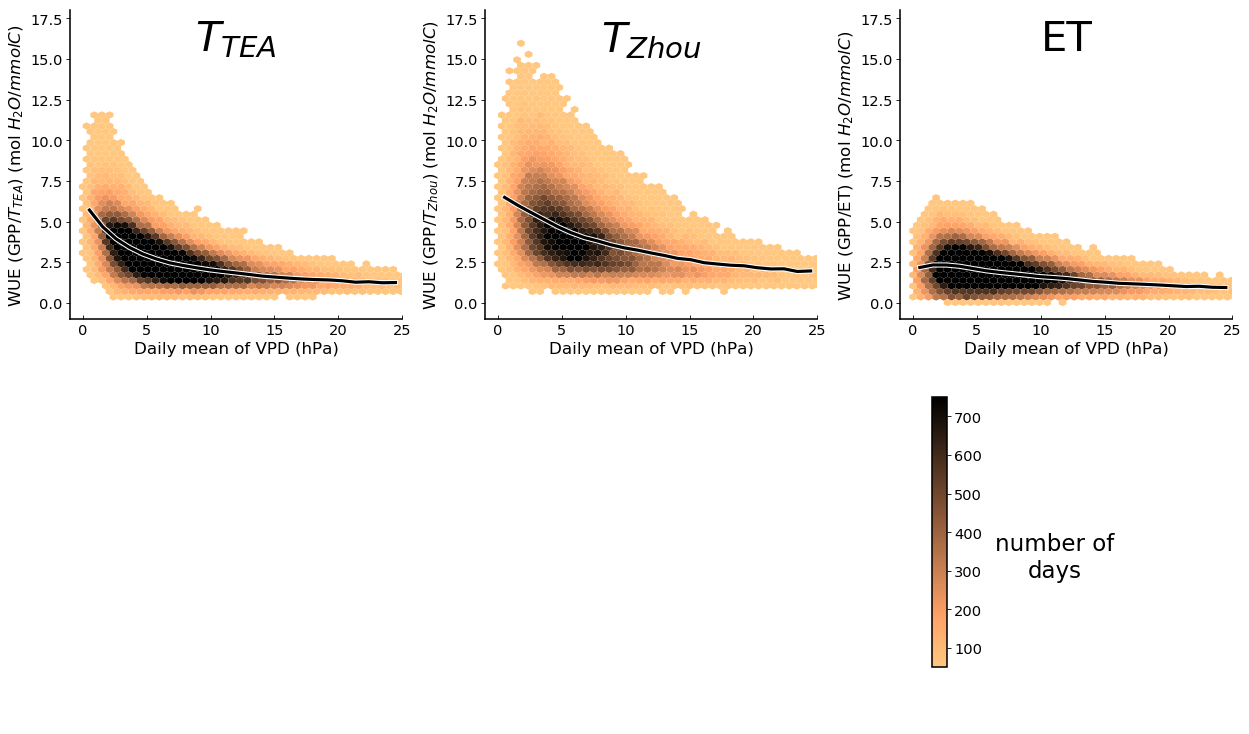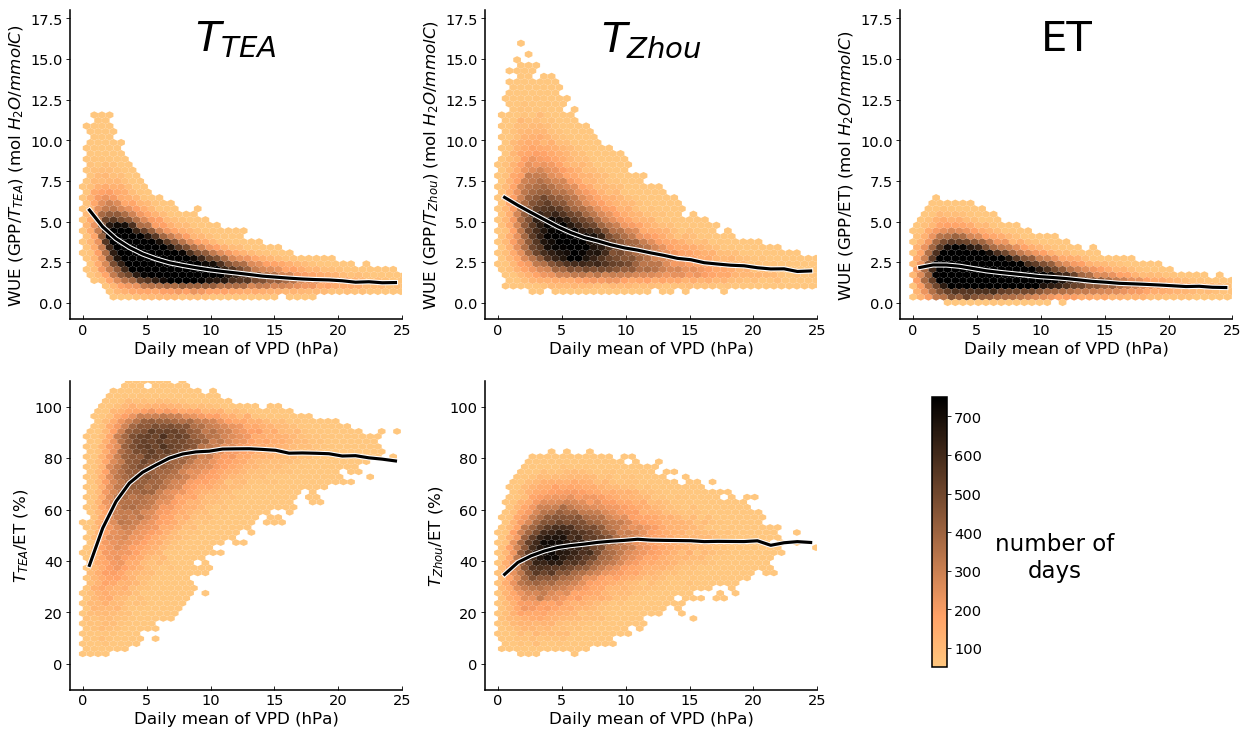Ecosystem scale estimates of transpiration:
an overview of methods for eddy covariance data.
Jacob Nelson, Oscar Perez-Priego, Rafael Poyatos, Sha Zhou, Yao Zhang,
Mirco Migliavacca, Nuno Carvalhais, Markus Reichstein, and Martin Jung
Why transpiration from eddy covariance?
- ► Continuous half-hourly time-step
- ► Diverse ecosystems and climates (>300 sites)
- ► Better understanding of carbon:water interactions

Why transpiration from eddy covariance?
- ► Continuous half-hourly time-step
- ► Diverse ecosystems and climates (>300 sites)
- ► Better understanding of carbon:water interactions

Why transpiration from eddy covariance?
- ► Continuous half-hourly time-step
- ► Diverse ecosystems and climates (>300 sites)
- ► Better understanding of carbon:water interactions

Why transpiration from eddy covariance?
- ► Continuous half-hourly time-step
- ► Diverse ecosystems and climates (>300 sites)
- ► Better understanding of carbon:water interactions

| Zhou |
∙ $T \propto GPP \cdot \sqrt{VPD}$ ∙ $T \approx ET$ during some periods∙ easiest to calculate |
| Perez-Priego |
∙ big leaf model with optimality∙ no $T \approx ET$ assumption ∙ expensive parameter estimation |
| TEA |
∙ models WUE via machine learning ∙ $T/ET$ high in dry periods∙ few assumptions on physiology |
Zhou et al. 2016 “Partitioning Evapotranspiration Based on the Concept of Underlying Water Use Efficiency” Water Resources Research.
Perez-Priego et al. 2018 “Partitioning Eddy Covariance Water Flux Components Using Physiological and Micrometeorological Approaches.” JGR Biogeosciences
Nelson et al. 2018 “Coupling Water and Carbon Fluxes to Constrain Estimates of Transpiration: The TEA Algorithm.” JGR Biogeosciences
| Zhou |
∙ $T \propto GPP \cdot \sqrt{VPD}$ ∙ $T \approx ET$ during some periods∙ easiest to calculate |
| Perez-Priego |
∙ big leaf model with optimality∙ no $T \approx ET$ assumption ∙ expensive parameter estimation |
| TEA |
∙ models WUE via machine learning ∙ $T/ET$ high in dry periods∙ few assumptions on physiology |
Zhou et al. 2016 “Partitioning Evapotranspiration Based on the Concept of Underlying Water Use Efficiency” Water Resources Research.
Perez-Priego et al. 2018 “Partitioning Eddy Covariance Water Flux Components Using Physiological and Micrometeorological Approaches.” JGR Biogeosciences
Nelson et al. 2018 “Coupling Water and Carbon Fluxes to Constrain Estimates of Transpiration: The TEA Algorithm.” JGR Biogeosciences
| Zhou |
∙ $T \propto GPP \cdot \sqrt{VPD}$ ∙ $T \approx ET$ during some periods∙ easiest to calculate |
| Perez-Priego |
∙ big leaf model with optimality∙ no $T \approx ET$ assumption ∙ expensive parameter estimation |
| TEA |
∙ models WUE via machine learning ∙ $T/ET$ high in dry periods∙ few assumptions on physiology |
Zhou et al. 2016 “Partitioning Evapotranspiration Based on the Concept of Underlying Water Use Efficiency” Water Resources Research.
Perez-Priego et al. 2018 “Partitioning Eddy Covariance Water Flux Components Using Physiological and Micrometeorological Approaches.” JGR Biogeosciences
Nelson et al. 2018 “Coupling Water and Carbon Fluxes to Constrain Estimates of Transpiration: The TEA Algorithm.” JGR Biogeosciences
| Zhou |
∙ $T \propto GPP \cdot \sqrt{VPD}$ ∙ $T \approx ET$ during some periods∙ easiest to calculate |
| Perez-Priego |
∙ big leaf model with optimality∙ no $T \approx ET$ assumption ∙ expensive parameter estimation |
| TEA |
∙ models WUE via machine learning ∙ $T/ET$ high in dry periods∙ few assumptions on physiology |
Zhou et al. 2016 “Partitioning Evapotranspiration Based on the Concept of Underlying Water Use Efficiency” Water Resources Research.
Perez-Priego et al. 2018 “Partitioning Eddy Covariance Water Flux Components Using Physiological and Micrometeorological Approaches.” JGR Biogeosciences
Nelson et al. 2018 “Coupling Water and Carbon Fluxes to Constrain Estimates of Transpiration: The TEA Algorithm.” JGR Biogeosciences
Questions that emerge
| ‣ Are the T estimates closer to the physiology than ET? |
| ‣ When do the different T estimates (dis)agree? |
| ‣ How do WUE (GPP/T) and T/ET vary across space and time? |
Questions that emerge
| ‣ Are the T estimates closer to the physiology than ET? |
| ‣ When do the different T estimates (dis)agree? |
| ‣ How do WUE (GPP/T) and T/ET vary across space and time? |
Questions that emerge
| ‣ Are the T estimates closer to the physiology than ET? |
| ‣ When do the different T estimates (dis)agree? |
| ‣ How do WUE (GPP/T) and T/ET vary across space and time? |
Questions that emerge
| ‣ Are the T estimates closer to the physiology than ET? |
| ‣ When do the different T estimates (dis)agree? |
| ‣ How do WUE (GPP/T) and T/ET vary across space and time? |
Questions that emerge
| ‣ Are the T estimates closer to the physiology than ET? |
| ‣ When do the different T estimates (dis)agree? |
| ‣ How do WUE (GPP/T) and T/ET vary across space and time? |
All 3 methods correlate with Sap Flux
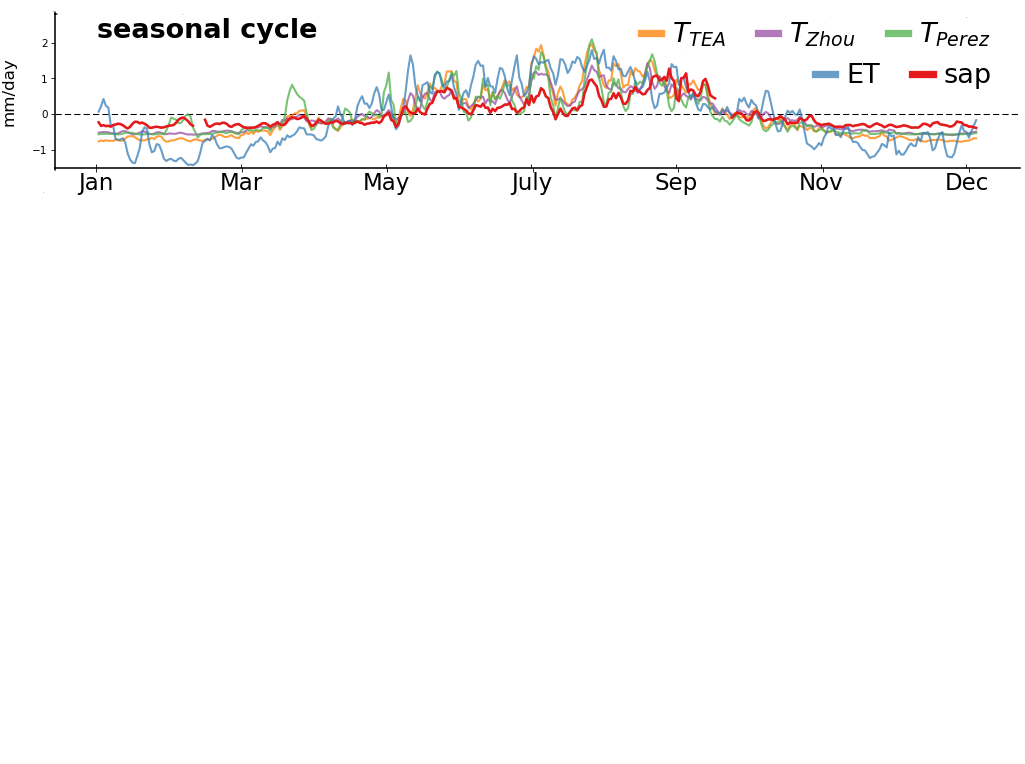
All 3 methods correlate with Sap Flux
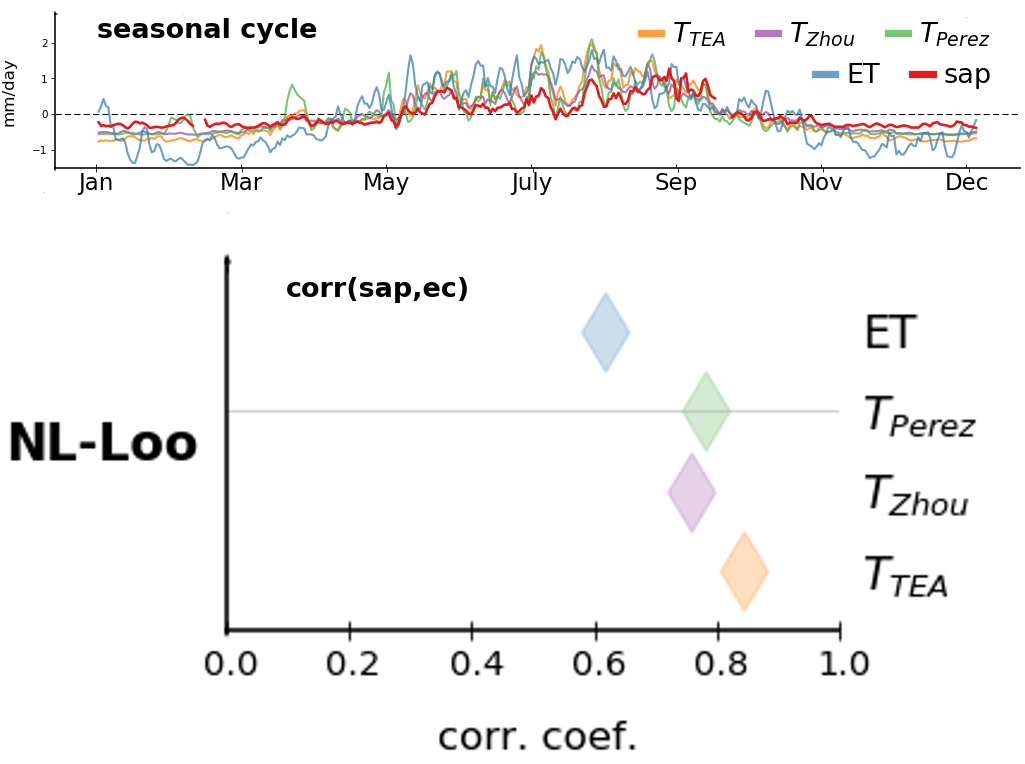
All 3 methods correlate with Sap Flux
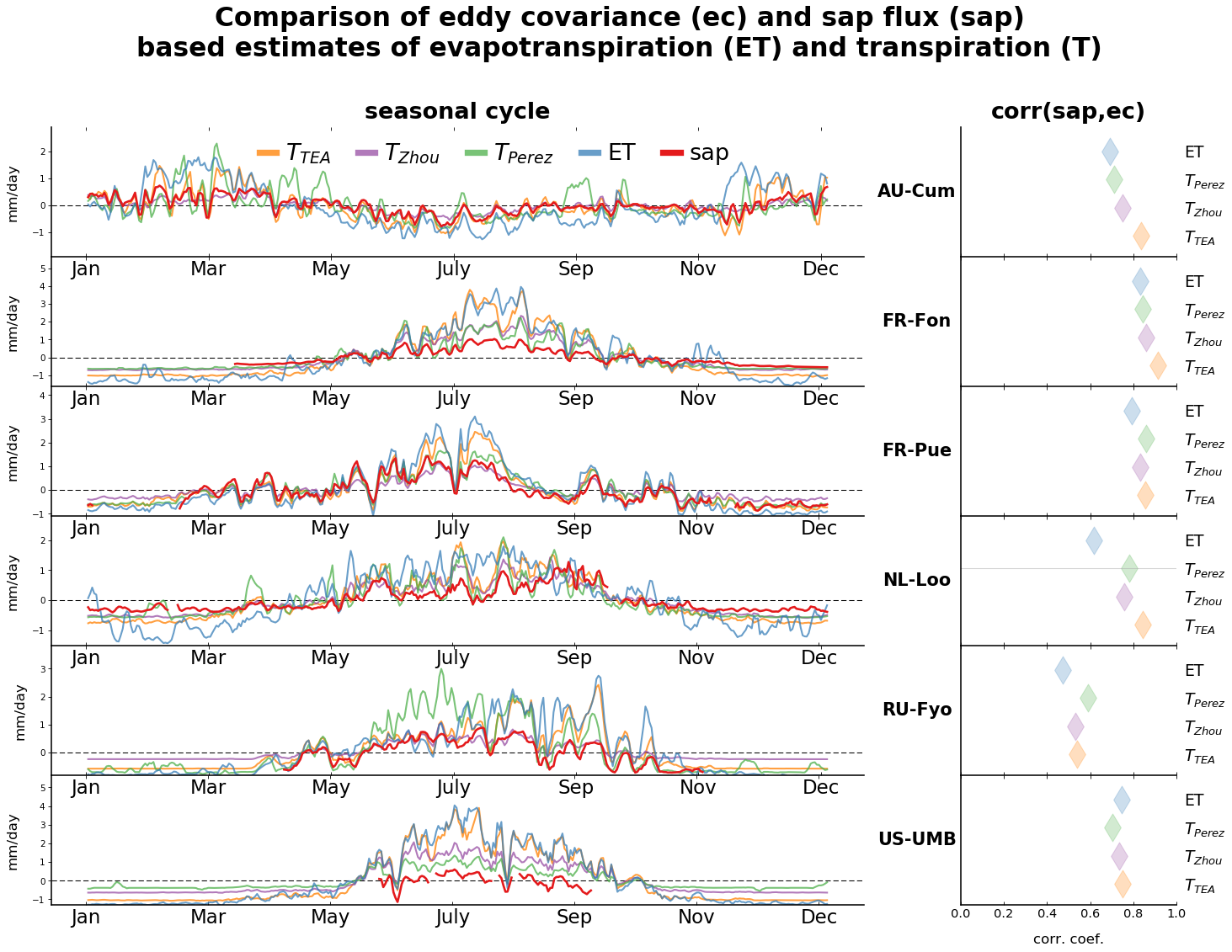
Questions that emerge
| ‣ Are the T estimates closer to the physiology than ET? |
| ‣ When do the different T estimates (dis)agree? |
| ‣ How do WUE (GPP/T) and T/ET vary across space and time? |
Questions that emerge
| ‣ Are the T estimates closer to the physiology than ET? |
| ‣ When do the different T estimates (dis)agree? |
| ‣ How do WUE (GPP/T) and T/ET vary across space and time? |
TEA and Zhou: seasonal cycles agree
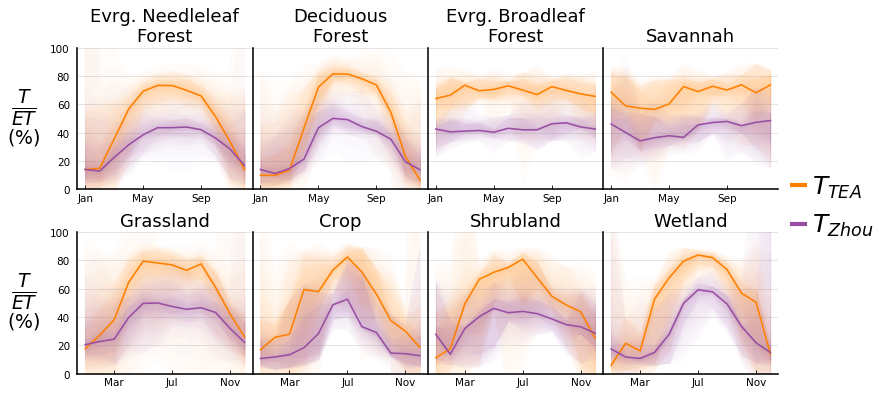
Questions that emerge
| ‣ Are the T estimates closer to the physiology than ET? |
| ‣ When do the different T estimates (dis)agree? |
| ‣ How do WUE (GPP/T) and T/ET vary across space and time? |
Questions that emerge
| ‣ Are the T estimates closer to the physiology than ET? |
| ‣ When do the different T estimates (dis)agree? |
| ‣ How do WUE (GPP/T) and T/ET vary across space and time? |
variability: spatial > interannual
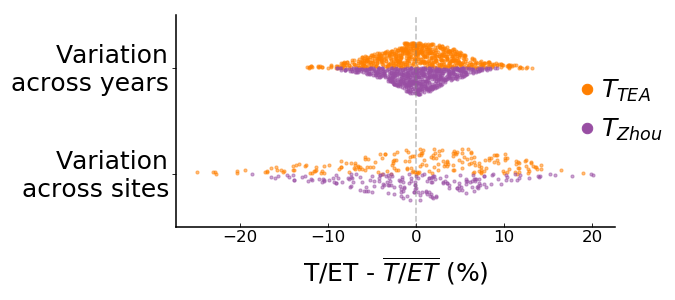
Conclusions
| ‣ Are the T estimates closer to the physiology than ET? |
| ∙ Yes: ✓ Sap Flux ✓ VPD responses |
| ‣ When do the different T estimates (dis)agree? |
| ∙ Methods have different magnitudes |
| ∙ Overall similar dynamics |
| ‣ How do WUE (GPP/T) and T/ET vary across space and time? |
| ∙ VPD and phenology over short time-scales |
| ∙ Ecosystem properties (soil, veg. type) across space |
Conclusions
| ‣ Are the T estimates closer to the physiology than ET? |
| ∙ Yes: ✓ Sap Flux ✓ VPD responses |
| ‣ When do the different T estimates (dis)agree? |
| ∙ Methods have different magnitudes |
| ∙ Overall similar dynamics |
| ‣ How do WUE (GPP/T) and T/ET vary across space and time? |
| ∙ VPD and phenology over short time-scales |
| ∙ Ecosystem properties (soil, veg. type) across space |
Conclusions
| ‣ Are the T estimates closer to the physiology than ET? |
| ∙ Yes: ✓ Sap Flux ✓ VPD responses |
| ‣ When do the different T estimates (dis)agree? |
| ∙ Methods have different magnitudes |
| ∙ Overall similar dynamics |
| ‣ How do WUE (GPP/T) and T/ET vary across space and time? |
| ∙ VPD and phenology over short time-scales |
| ∙ Ecosystem properties (soil, veg. type) across space |
Conclusions
| ‣ Are the T estimates closer to the physiology than ET? |
| ∙ Yes: ✓ Sap Flux VPD responses |
| ‣ When do the different T estimates (dis)agree? |
| ∙ Methods have different magnitudes |
| ∙ Overall similar dynamics |
| ‣ How do WUE (GPP/T) and T/ET vary across space and time? |
| ∙ VPD and phenology over short time-scales |
| ∙ Ecosystem properties (soil, veg. type) across space |
Conclusions
| ‣ Are the T estimates closer to the physiology than ET? |
| ∙ Yes: ✓ Sap Flux ✓ VPD responses |
| ‣ When do the different T estimates (dis)agree? |
| ∙ Methods have different magnitudes |
| ∙ Overall similar dynamics |
| ‣ How do WUE (GPP/T) and T/ET vary across space and time? |
| ∙ VPD and phenology over short time-scales |
| ∙ Ecosystem properties (soil, veg. type) across space |
Conclusions
| ‣ Are the T estimates closer to the physiology than ET? |
| ∙ Yes: ✓ Sap Flux ✓ VPD responses |
| ‣ When do the different T estimates (dis)agree? |
| ∙ Methods have different magnitudes |
| ∙ Overall similar dynamics |
| ‣ How do WUE (GPP/T) and T/ET vary across space and time? |
| ∙ VPD and phenology over short time-scales |
| ∙ Ecosystem properties (soil, veg. type) across space |
Conclusions
| ‣ Are the T estimates closer to the physiology than ET? |
| ∙ Yes: ✓ Sap Flux ✓ VPD responses |
| ‣ When do the different T estimates (dis)agree? |
| ∙ Methods have different magnitudes |
| ∙ Overall similar dynamics |
| ‣ How do WUE (GPP/T) and T/ET vary across space and time? |
| ∙ VPD and phenology over short time-scales |
| ∙ Ecosystem properties (soil, veg. type) across space |
Conclusions
| ‣ Are the T estimates closer to the physiology than ET? |
| ∙ Yes: ✓ Sap Flux ✓ VPD responses |
| ‣ When do the different T estimates (dis)agree? |
| ∙ Methods have different magnitudes |
| ∙ Overall similar dynamics |
| ‣ How do WUE (GPP/T) and T/ET vary across space and time? |
| ∙ VPD and phenology over short time-scales |
| ∙ Ecosystem properties (soil, veg. type) across space |
Conclusions
| ‣ Are the T estimates closer to the physiology than ET? |
| ∙ Yes: ✓ Sap Flux ✓ VPD responses |
| ‣ When do the different T estimates (dis)agree? |
| ∙ Methods have different magnitudes |
| ∙ Overall similar dynamics |
| ‣ How do WUE (GPP/T) and T/ET vary across space and time? |
| ∙ VPD and phenology over short time-scales |
| ∙ Ecosystem properties (soil, veg. type) across space |
Conclusions
| ‣ Are the T estimates closer to the physiology than ET? |
| ∙ Yes: ✓ Sap Flux ✓ VPD responses |
| ‣ When do the different T estimates (dis)agree? |
| ∙ Methods have different magnitudes |
| ∙ Overall similar dynamics |
| ‣ How do WUE (GPP/T) and T/ET vary across space and time? |
| ∙ VPD and phenology over short time-scales |
| ∙ Ecosystem properties (soil, veg. type) across space |
Conclusions
| ‣ Are the T estimates closer to the physiology than ET? |
| ∙ Yes: ✓ Sap Flux ✓ VPD responses |
| ‣ When do the different T estimates (dis)agree? |
| ∙ Methods have different magnitudes. |
| ∙ Overall similar dynamics. |
| ‣ How do WUE (GPP/T) and T/ET vary across space and time? |
| ∙ VPD and phenology over short time-scales |
| ∙ Ecosystem properties (soil, veg. type) across space |
TEA and Zhou: correlated in space and time
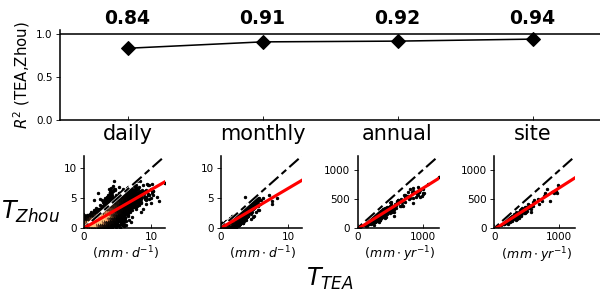
Zhou

Perez-Priego
